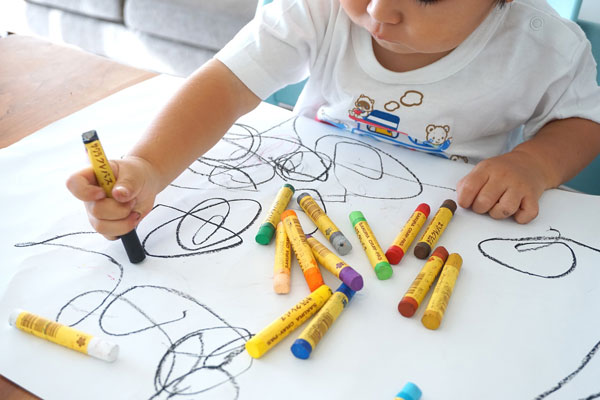当前位置: Language Tips> 英语学习专栏
你去朋友家做客,冰箱上贴着小孩的涂鸦。你可能看不太懂画的是什么,但千万不要以为小孩们没有想法。不要小瞧他们的一个点、一条线、一个圆,他们的画是很多抽象画大师的启蒙。绘画也是孩子自我表达的途径:画中有莫扎特,画中有安徒生,每幅画都是他们想象的后花园。

By Isabel Fattal 柒月 选注
A parent might place his daughter’s tadpole drawing on the fridge out of a love for his child rather than for the funky-looking image, but for many people, that tadpole art is actually quite exquisite. In fact, adult abstract artists were often inspired by children’s drawing. Observers have found similar patterns in modern abstract art and kids’ drawing; one example is the “X-ray” drawing, or a drawing in which the “inside” of a person is made visible (like a baby shown inside a woman’s stomach). For the museum-goers out there who tend to point to a piece of modern art and say, “My kid could have made that!” it’s worth remembering that often, that’s actually just what the artist had in mind.
Lucky accident or artistic prodigy, acknowledging that young kids aren’t as intent on producing a realistic rendering helps demonstrate what the drawing experience means to them. For many kids, drawing is exhilarating not because of the final product it leads to, but because they can live completely in the world of their drawing for a few minutes. Adults may find it hard to relate to this sort of full-body, fleeting experience. But the opportunities for self-expression that drawing provide have important, even therapeutic, value for kids.
Even simple scribbles are meaningful. Now it’s been shown that when children are scribbling, they’re representing through action, not through pictures. Liane Alves, a prekindergarten teacher, recalled a student who presented her with a drawing featuring a single straight line across the page. Alves assumed the child hadn’t given too much thought to the drawing until he proceeded to explain that the line was one of the mattresses from The Princess and the Pea, one of the fairy tales they read in class.
Maureen Ingram, who’s a preschool teacher at the same school, said her students often tell different stories about a given piece of art depending on the day, perhaps because they weren’t sure what they intended to draw when they started the picture. “We as adults will often say, ‘I’m going to draw a horse,’ and we set out... and get frustrated when we can’t do it,” Ingram said. “They seem to take a much more sane approach, where they just draw, and then they realize, ‘it is a horse.’”
Ultimately, what may be most revealing about kids’ art isn’t the art itself but what they say during the drawing process. They’re often telling stories that offer a much clearer window into their world than does the final product. Asking them what their drawing is “supposed to be” wouldn’t yield as many answers, either; some have even argued that kids might be naming their work because they’re used to the ritual of their teachers asking them to describe their drawing and then writing a short title on the piece of paper. Studies suggest that kids will create an elaborate narrative while drawing, but when telling adults about their work they’ll simply name the items or characters in the image.
And what about those odd or scary-looking drawings? Does that mean kids are telling themselves stories that are odd or scary?
It’s hard to say, but it’s rarely a good idea to over-interpret it. Ellen Winner, a psychology professor at Boston College, pointed to parents who worry when their kid draws a child the same size as the adults, wondering whether she’s suffering from, say, a feeling of impotence —a desire to feel as powerful as older people. But the likely reason is that the child hasn’t yet learned how to differentiate size in his or her representation; the easiest solution is to just make all the figures the same size.
What’s most important to remember is that “children’s art has its own logic,” Winner said. “Children are not being crazy.”
Vocabulary
1. scribble: 乱涂乱画。
2. 一个家长可能会把他女儿的蝌蚪画贴在冰箱上,这是出于对孩子的爱,而不是因为画本身有多独特。但是对于很多人来说,这幅画确实是一件相当棒的艺术品。tadpole: 蝌蚪;funky: 独特的;exquisite: 精美的。
3. 对于那些经常去博物馆参观,并且总爱指着一幅现代艺术作品说“我家孩子也会这样画”的人来说,我们需要记住的是,创作这幅作品的艺术家心里其实也是这么想的。goer: 常去……的人。
4. 无论是巧合还是艺术上的奇迹,承认孩子们并非要制造现实的翻版可以帮助我们了解绘画对于他们来说到底意味着什么。prodigy: 奇迹;rendering: 翻译,表现,realistic rendering是“对于现实的翻译或再呈现”,这里指孩子的画加入了很多想象成分,并不是基于真实的描绘。
5. exhilarating: [ɪɡ'zɪləretɪŋ] 令人愉快的。
6. relate to: 了解,有共鸣;fleeting: 短暂的,转瞬即逝的。
7. therapeutic: 治疗的,治愈性的。
8. prekindergarten: 进幼儿园前的。
9. mattress: 床垫;“The Princess and the Pea”: 《豌豆公主》,出自安徒生童话。
10. revealing: 有启迪作用的,揭示秘密的。
11. yield: 产生;ritual: 惯例。
12. impotence: 虚弱,无力。
13. differentiate: 区分,辨别。
(来源:英语学习杂志 编辑:董静)
上一篇 : 詹妮弗•安妮斯顿:什么是成功女性
下一篇 :
关注和订阅

电话:8610-84883645
传真:8610-84883500
Email: languagetips@chinadaily.com.cn